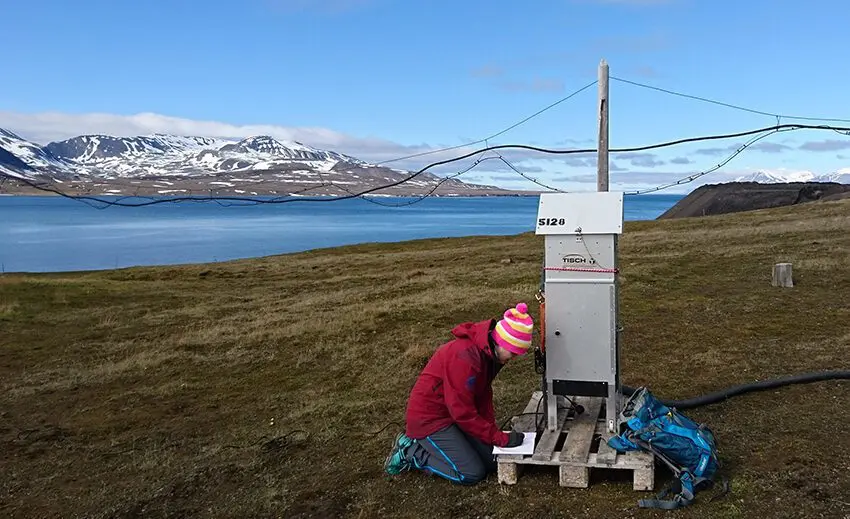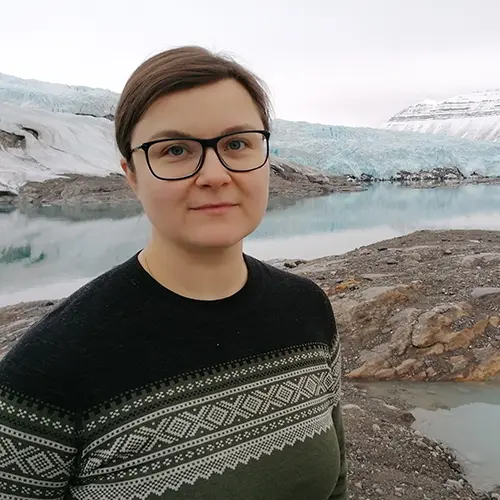Toxic atmospheric Polycyclic Aromatic Compounds measured in Svalbard

Tatiana Drotikova on fieldwork in Grønfjorden. Photo: Private.
Top image: Tatiana Drotikova on fieldwork in Grønfjorden. Photo: Private.
For the first time, carcinogenic and toxic polycyclic aromatic compounds (PACs) have been measured in Svalbard air. Tatiana Drotikova’s PhD work shows that these PACs contribute significantly to local man-made emissions. Drotikova will defend her PhD thesis on 24 November 2021.
22 November 2021
Press release from the University Centre in Svalbard (UNIS) and the Norwegian University of Life Sciences
The doctoral work of Tatiana Drotikova shows that local anthropogenic emissions are primary contributors to the levels of atmospheric PACs in Longyearbyen. PACs are chemicals of emerging concern in the Arctic. Local snowmobiles, cars, marine traffic, and the coal power plant are identified as the primary sources of PACs in the air in Longyearbyen. Measured concentrations of PACs were up to 30 times higher than those in the air in Ny-Ålesund, further north of Longyearbyen.
Polycyclic aromatic compounds (PACs) are ever-present organic, gaseous, and particulate chemicals primarily emitted from incomplete combustion of fossil fuels and biomass. Several PACs are classified as carcinogens and toxicants, and they are mainly distributed globally by the atmosphere.
Due to increasing regional emissions, lower degradation rates in polar conditions, and accumulation in environment, flora and fauna, PACs have been identified as chemicals of emerging Arctic concern. 16 priority PACs levels are monitored at Arctic stations. However, the main focus has been on long-range atmospheric transport of pollutants from remote sources, and little is documented about local Arctic sources. The doctoral work of Drotikova remedies this lack of knowledge about local PACs sources.

Drotikova’s study was conducted in Longyearbyen, the biggest settlement in Svalbard. Large volume air samples were collected in the town’s vicinity in order to estimate the contribution of local emissions. Plume samples from the local coal power plant were also analysed. The traditional list of 16 priority PACs was extended with oxy- and nitro-PACs, which are equally or more toxic and may act as direct mutagens and carcinogens for humans and wildlife. In total, 91 PACs were studied in this thesis.
Measured seasonal PAC concentrations were highly variable. Investigation of air mass transport revealed notable contribution of local anthropogenic emissions (e.g., snowmobile, car, and marine traffic and the coal power plant) and confirmed efficient long-range atmospheric transport of contaminants from north-western Eurasia in the winter.
Furthermore, the study showed that regional meteorology plays a predominant role in local pollution dispersion. Specific polar climate conditions caused near-ground pollution accumulation and resulted in the annual highest PAC concentrations in spring 2018. The concentrations were comparable to and partly exceeded the European annual mean levels, breaking a stereotype about pristine Arctic conditions.
Drotikova’s thesis opens up many novel aspects about the occurrence, seasonal variations, sources, atmospheric behaviour, degradation, and persistence of an extensive suite of selected PACs. This knowledge is essential for authorities working on national and regional monitoring and remediation strategies and might further provide confidence for choosing new compound candidates to be routinely measured in densely populated areas of the Arctic.
Disputation
Tatiana Drotikova will defend her PhD thesis entitled “Polycyclic aromatic compound (PACs) in ambient air of Svalbard. Concentrations, seasonal trends, sources, and transformation processes” on Wednesday 24 November 2021 at 13:00 in Lassegrotta at UNIS and also on Zoom.
More information about the disputation (Norwegian University of Life Sciences)

About the candidate
Tatiana Drotikova (36) is from Ryazan, Russia.
She completed a MSc in Analytical Chemistry from the Lomonosov Moscow State University (MSU), before starting as a PhD candidate at UNIS and Norwegian University of Life Sciences.
Contact information:
E-mail: tatiana.drotikova@unis.no
Phone: +47 416 26 360